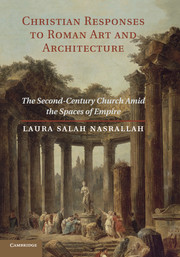 Christian Responses to Roman Art and Architecture
Christian Responses to Roman Art and Architecture INTRODUCTION
Summary
How perfectly ordinary someone says looking at the same thing or
I'd like to get to the bottom of that one.
from Martha Ronk, “In a Landscape of Having to Repeat”When second-century christians penned their thoughts, they usually wrote from cities crowded with monumental buildings whose erection was funded by emperors and elites. These Christian apologists were concerned with themes of justice, power, culture, and ethnicity; they wrote about how the world around them blurred the lines between human and divine, and how it defined piety and proper religious behavior. In the streets, Christians and their neighbors were jostled amid a growing population of statues that depicted the wealthy and powerful as gods, or nearly so. Christians among others crowded into agoras and forums full of architecture that proclaimed the triumph of the Roman Empire, even as such spaces often retained or repeated architecture and images from classical Greece and the Hellenistic cities of Alexander and his successors. Christians among others questioned the truth and value of these representations.
In this book I bring together literary texts and archaeological remains to help us to understand how religious discourse emerges not in some abstract zone, but in lived experiences and practices in the spaces of the world. I read early Christian writings addressed to the Roman emperors and to the Greeks in relation to select buildings and images, especially statuary.
- Type
- Chapter
- Information
- Christian Responses to Roman Art and ArchitectureThe Second-Century Church amid the Spaces of Empire, pp. 1 - 18Publisher: Cambridge University PressPrint publication year: 2010


